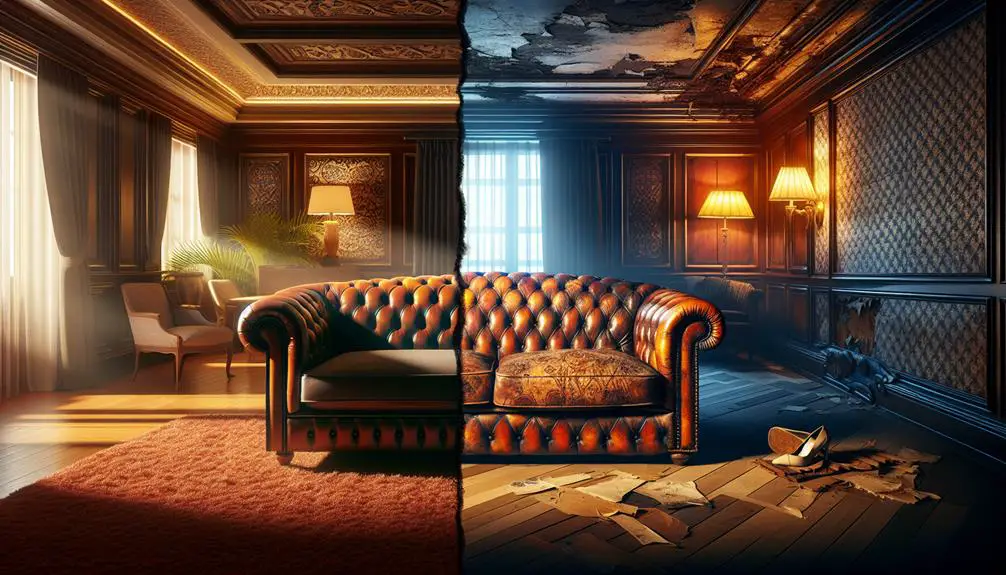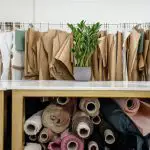I've always been drawn to leather for its comfort and style. Over time, it molds to your body and adjusts to temperature, which means it's super comfy and looks great. Plus, it's durable, resisting scratches and wear. However, it isn't perfect. Leather items are pricey and require a lot of care. They can be damaged by moisture and need special cleaning methods. Moreover, leather isn't the kindest option for animals and the environment, often involving harsh chemicals. Still interested? There's a lot more to explore about leather's uses and impacts on our world.
Table of Contents
Key Takeaways
- Leather conforms to body shape over time, offering a custom fit and enhanced comfort.
- It's highly durable, resisting scratches, punctures, and fading effectively.
- Leather requires high maintenance and special care to prevent damage from moisture.
- The production of leather involves harsh chemicals, contributing to environmental pollution.
- Despite its high cost and ethical concerns regarding animal use, leather adds luxury and aesthetic appeal to products.
Leather Durability and Longevity
Leather's remarkable durability means it can last for years with the right care. It's all about understanding how tough this material is against wear and tear. Whether it's a jacket, boots, or a sofa, leather holds up well under everyday stress. This isn't just about looking good; it's about investing in something that really lasts.
What's great is leather's ability to handle a lot. It resists scratches, punctures, and even fading. I've noticed that items I use daily, like my leather bag, actually look better over time rather than worn out. This flexibility isn't just physical. Leather adapts to different environments robustly – it can take on mud, water, and even exposure to fire without falling apart.
Moreover, leather isn't just a tough guy; it's also a comfort king. Being a flexible material, it molds to my body and adjusts to temperature changes, making it comfortable year-round. These qualities make leather not just a purchase but a smart long-term investment. So, if you're looking for something that combines durability with longevity and comfort, leather's definitely a top contender.
Aesthetic Appeal of Leather
The unique textures, grains, and colors of leather give it a high-quality appearance that's hard to match. When I think about what draws people to leather, it's not just its durability but its undeniable aesthetic appeal. Leather's unique texture and the way it feels to the touch contribute to its premium look and feel. It's like each piece tells its own story through its distinct marks and imperfections, which only adds to its charm.
Over time, I've noticed that leather goods don't just maintain their look; they actually get better. They become softer and gain character, which is a real testament to leather's enduring appeal. This aging process enhances the leather's beauty, unlike many other materials that simply wear out. It's fascinating how leather can be both tough and luxurious at the same time.
Moreover, the versatility of leather is impressive. It offers a variety of finishes and colors, allowing for personalization and uniqueness in products. This versatility ensures that leather remains a top choice for anyone valuing both style and substance. It's clear why leather is synonymous with luxury—it's all about the rich, inviting texture and its ability to stand out gracefully.
Leather in Fashion Industry
I've noticed that leather plays a pivotal role in the fashion industry due to its durability and luxurious appeal. This durable material is not just tough; it also ages gracefully, adding character to leather products like jackets and boots. Fashion aficionados appreciate leather for its high-quality product finish which effortlessly elevates any ensemble.
Leather's presence in the fashion industry is undeniable. From runway shows to street fashion, it adds a touch of sophistication and elegance. High-end brands often hinge their collections around leather due to its timeless appeal and luxury vibe. It's fascinating how a single leather jacket can transform a basic outfit into a statement look.
Here's a quick look at how leather serves the fashion industry:
| Leather Product | Benefit | Fashion Impact |
|---|---|---|
| Jackets | Long-lasting | Timeless style |
| Pants | Molds to body | Unique fit and comfort |
| Skirts | Versatile wear | Elegant appearance |
| Bags | Durable material | Enhances any outfit |
| Shoes | Comfort over time | Completes the look |
Each of these items showcases leather's versatility and pivotal role in fashion, making it a staple in our wardrobes for years to come.
Leather in Automotive Applications
When we talk about leather in car interiors, durability is a key factor. It not only survives the frequent wear and tear but also makes the car look more stylish.
However, keeping it in great shape requires some regular maintenance and care.
Durability in Vehicle Interiors
Leather really stands out for its durability in vehicle interiors, handling daily wear and tear like a champ. When you hop into a car with leather seats, you're not just sitting on any material; you're experiencing a surface that's built to last and provide comfort. Let me tell you, it makes a difference.
- Resistant to Sunlight: Leather holds up against harsh sun exposure without cracking.
- Withstands Temperature Changes: Whether it's a cold winter morning or a hot summer day, leather remains unphased.
- Easier to Clean: Spills? No problem. A wipe is often enough.
- Longevity: Leather doesn't just wear down; it ages gracefully, getting better with time.
- Comfort: Adjusts to your body temperature, making every drive comfortable.
Aesthetic Appeal Enhancement
Car interiors decked out in leather instantly ramp up the luxury vibe, giving off a premium feel that's hard to match. When I'm looking at cars, the luxurious look of leather seats is a major draw. It's not just about style—leather's durability and longevity are top-notch, which means it can handle the daily wear and tear of driving without losing its appeal.
Here's a quick breakdown of why leather is awesome for car interiors:
| Feature | Benefit | Relevance to Cars |
|---|---|---|
| Luxurious Look | Enhances aesthetic appeal | Makes car interiors visually appealing |
| Premium Feel | Adds comfort and sophistication | Upscales the driving experience |
| Durability | Withstands frequent use | Ideal for long-term quality |
Maintenance and Care Requirements
To keep your car's leather interior looking great, you'll need to regularly clean and condition it. Leather requires consistent attention to maintain its elegance and comfort. Proper care involves more than just a quick wipe down. Here's what you should consider:
- Use specialized cleaners and conditioners designed specifically for leather to keep it supple.
- Protect from harsh sunlight and extreme temperatures to prevent the leather from drying and cracking.
- Avoid harsh chemicals and abrasive tools that can damage the surface.
- Condition regularly to restore moisture and prevent aging.
- Engage in regular maintenance routines to ensure the longevity and beauty of your leather, making every drive a luxury experience.
Environmental Impact of Leather
Manufacturing leather significantly impacts the environment, from chemical pollution to deforestation. The process involves a lot of harmful chemicals, like chromium and formaldehyde, which contribute to air, soil, and water pollution. The leather industry also leads to deforestation for livestock grazing, which causes soil erosion and loss of biodiversity. This isn't just bad for the trees; it affects the whole ecosystem.
When talking about the environmental impacts of leather, it's crucial to mention the chemicals in the tanning process. They're pretty harsh and raise significant environmental concerns because of their toxicity and the risk they pose to ecosystems if not managed properly. The disposal of these chemicals is another big issue. If it's done improperly, it can lead to further contamination of water and soil.
Despite these issues, there's a growing push within the industry for environmental friendliness. Efforts are being made to reduce chemical usage and adopt more eco-friendly practices. It's a tough road, but many in the leather business are working towards making the process less harmful to our planet. They're trying to find a balance between tradition and the need to protect the environment.
Ethical Concerns in Leather Sourcing
Leather sourcing often involves ethical dilemmas, including the inhumane treatment of animals. As someone who deeply cares about animal welfare, I find it troubling to learn about the practices involved in some leather production processes. Practices like mulesing and live-plucking are downright distressing and highlight the need for stricter regulations and more ethical sourcing standards in the industry.
Here are some emotional points to consider:
- Suffering: Animals endure painful procedures without adequate care or anesthesia.
- Fear: Imagine the terror animals feel being handled roughly in overcrowded farms.
- Neglect: Lack of proper regulations often leads to neglect, where animals suffer from inadequate food, water, or shelter.
- Loss: Natural behaviors are typically denied in these settings, causing psychological stress.
- Hope: Alternatives like vegan leather offer a glimpse of how we can reduce animal suffering.
Ethical sourcing isn't just about adhering to the minimum standards; it's about considering the moral implications of our choices and striving towards practices that honor the dignity of all beings involved. As consumers, we're empowered to demand better by choosing products that align with our values on animal welfare and ethics.
Leather Maintenance and Care
Taking care of leather isn't just about keeping it clean; it's crucial for extending its life and maintaining its beauty.
I'll explore some effective cleaning techniques and share tips on how to make your leather items last longer.
Let's get into how you can protect your investment and enjoy your leather products for years to come.
Cleaning Techniques
How do we best maintain and care for leather items? Regularly wiping surfaces with a damp cloth is a great starting point. From the tanning process to the final product, each step in leather production impacts how we use cleaning techniques to preserve our leather goods. A gentle touch and the right products can make all the difference.
- Use a mild soap or specific leather cleaner to gently remove tougher dirt without damaging the surface.
- Apply a leather conditioner after cleaning to restore moisture and keep the leather supple.
- Avoid direct sunlight and heat to prevent the leather from fading and drying out.
- Tackle stains immediately with suitable products to avoid permanent marks.
- Follow manufacturer's guidelines to ensure the best care for your specific leather item.
Longevity Tips
To keep your leather items looking great for years, regular maintenance is crucial. I've found that using leather-specific products for cleaning and conditioning really helps maintain their quality and appearance.
Proper storage is also key. I make sure to keep my leather goods away from direct sunlight and moisture to prevent damage and discoloration. It's important to avoid extreme temperatures and harsh chemicals, which can shorten their lifespan.
I use a soft cloth or brush to gently remove any dirt and debris, which helps avoid scratches and wear. Regularly applying protectants or conditioners keeps the leather moisturized and flexible, boosting its durability and ensuring it stays in top condition for a long time.
Cost Analysis of Leather Products
Leather products often come with a higher price tag due to the premium materials and skilled craftsmanship they require. When you're weighing whether to invest in leather, consider both the upfront cost and the long-term value. It's not just about paying for a product; it's about investing in quality that lasts.
Here's a quick breakdown of what drives up the cost:
- Type of Leather: The kind of leather, whether it's full-grain, top-grain, or bonded, significantly impacts the price. Full-grain leather is the most durable and expensive.
- Craftsmanship: The meticulous effort and expertise required to craft a leather item are unparalleled. This craftsmanship justifies the higher cost.
- Longevity: Leather's ability to outlast other materials makes it a smart buy despite the initial expense. It's not just a purchase; it's an investment.
- Care Requirements: Maintaining leather might add to your cost, but proper care ensures it remains in prime condition, protecting your investment.
- Market Factors: The availability of raw materials and current market trends can also influence the cost of leather goods.
Understanding these factors can help you appreciate the value behind every dollar you spend on leather products.
Leather Versatility and Uses
Leather's versatility really shines when you look at how widely it's used.
From trendy jackets and comfy sofas to the sleek interiors of cars, it's got a role in so many products.
Each application not only uses leather's durability but also adds a touch of style and quality that's hard to match with other materials.
Diverse Fashion Applications
I've noticed that leather's flexibility and strength make it a top choice for everything from stylish jackets to durable shoes. In the world of fashion, leather stands out not just for its durability but also for its comfort. Its unique ability to blend into various fashion applications is truly remarkable. Here's how leather makes its mark:
- Timeless Jackets: Adds a layer of sophistication and classic style.
- Luxury Handbags: Offers a touch of elegance that elevates any outfit.
- Sturdy Belts: Combines functionality with style, lasting for years.
- Comfortable Footwear: Molds to your feet for unmatched comfort.
- Fashionable Accessories: Completes any look with a hint of chic.
Leather's luxurious and versatile nature makes it indispensable in fashion.
Furniture and Decor Options
When it comes to sprucing up your home, opting for leather furniture and decor can transform any space into a haven of sophistication and comfort. Leather's versatility means it's not just for sofas; it's also perfect for chairs, ottomans, and even wall panels. The quality and longevity of leather furniture make it a standout choice. It's a material that can withstand the rigors of daily life, improving with age if given the right maintenance to keep it looking great.
| Feature | Benefit |
|---|---|
| Durability | Withstands daily usage |
| Easy Care | Simple maintenance to keep |
| Aesthetic | Timeless, luxurious appeal |
| Comfort | Improves with age |
Leather really is a smart choice for anyone looking to invest in their living space.
Automotive Interior Choices
In the world of automotive interiors, choosing leather means opting for both luxury and practicality. I've always admired how leather upholstery elevates a car's aesthetic. It's not just about looks; the durability and comfort of leather make it a top choice for anyone serious about their vehicle's interior.
- Luxurious Appearance: Leather adds a touch of class that's hard to beat.
- Comfort: Soft and inviting, leather seats offer unmatched ride comfort.
- Durability: High-quality leather withstands wear and tear, lasting longer than other materials.
- Easy Maintenance: A simple wipe down keeps it looking new.
- Customizable: Available in various colors and textures to match any style.
It's clear why leather remains a favored option for car interiors.
Health and Comfort Considerations
Leather's breathability not only makes it comfortable but also helps regulate your body temperature, keeping you cool or warm depending on the weather. It's truly a remarkable material that adjusts to your body's temperature, enhancing comfort in varied climates. This breathable material means you're less likely to sweat, making leather perfect for extended wear. Whether I'm gearing up for a long day at work or a casual outing, leather ensures I stay comfy.
The flexibility of leather is another huge plus. It conforms to your body's shape over time, which means my leather jacket or boots become more comfortable the more I wear them. It's like each piece is custom-fitted just for me!
Here's a simple table that sums up why leather's health and comfort benefits are so compelling:
| Benefit | Emotion Evoked |
|---|---|
| Custom Fit | Feeling of uniqueness |
| Temperature Regulation | Sense of security |
| Extended Comfort | Relief and satisfaction |
Frequently Asked Questions
What Are the Advantages of Leather?
I love leather because it's incredibly durable, ages beautifully, and has a luxurious look. It's versatile in style and also naturally resistant to elements like water and heat, making it very practical.
What Are Some Disadvantages of Leather?
Leather's downsides include its environmental impact from toxic tanning chemicals and deforestation. It also raises animal welfare concerns and requires considerable upkeep, which, along with its high cost, may not suit everyone's budget.
What Are the Weaknesses of the Leather Industry?
The leather industry's weaknesses include severe environmental impacts from chemical use, ethical concerns over animal treatment, and deforestation. It's also plagued by inadequate regulations, which compromise both sustainability and animal welfare.
What Are the Positive Properties of Leather?
I'd say leather's positive properties include its durability, luxury appearance, and versatility. It's naturally resistant to elements and ages beautifully, becoming softer and more attractive over time.
- Does Chiffon Fabric Stink - July 15, 2025
- Does Chiffon Fabric Affect the Economy - July 15, 2025
- Does Cotton Fabric Have a Nap - July 15, 2025







